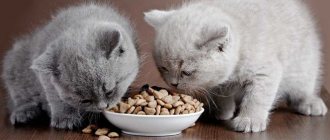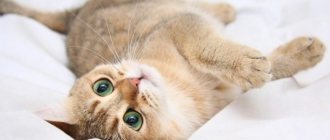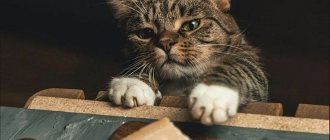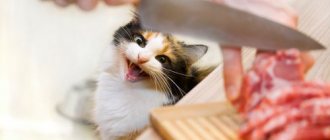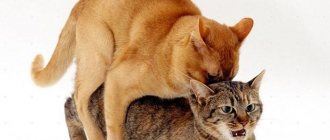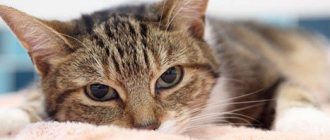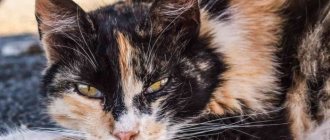Owners of purebred cats often ask veterinarians how many times a year a pet can kitten. Kittens give birth every 1-2 days. at 12 months. But between pregnancies a recovery period is needed (8-12 months), after which you can breed the cat again. To regulate offspring, various hormonal agents are used that dull sexual desire. But you should not abuse them, so as not to disrupt the functioning of your pet’s body.
Duration of pregnancy
A cat's pregnancy lasts on average about 9 weeks. A more accurate period depends on many factors such as age, weight and breed characteristics. For example, owners have found that the process of bearing offspring in short-haired females lasts 58-68 days, in cats with long and medium-length hair it lasts 63-72 days.
How many kittens can a cat give birth to?
The length of pregnancy is also affected by the number of babies inside the womb. The more there are, the earlier the due date will come. Females bearing one to two kittens are able to walk for as long as possible before giving birth. In addition, their health depends on the number of cubs. Statistics show that babies from multiple litters are weaker and sicker.
For your information! In one litter, a female can bring from 2 to 8 kittens, the exact number of which depends on many factors.
This is interesting: The cat itches until it hurts and at the same time its hair falls out
Use of contraceptives
Special pharmacological preparations containing synthetic hormones can alleviate the condition of an animal during estrus by reducing the intensity of signs of sexual heat. However, more and more veterinarians are urging owners to stop using them due to complications that arise, which include:
- purulent inflammation of the uterus;
- ovarian cysts;
- nymphomania;
- infertility;
- diabetes;
- dysfunction of the adrenal glands;
- benign and malignant tumors of the mammary glands and uterus.
As an alternative, females can be given sedatives to relieve emotional stress.
Important! The use of any medications must be agreed with a veterinarian, since cats have a breed intolerance to certain chemicals. Uncontrolled use of even seemingly harmless drugs can cause paralysis of the respiratory center, cardiac arrest and other symptoms leading to death.
Necessary preparation
After successful conception, the formation of future kittens begins, which takes 60-65 days. During this time, it is recommended to find a veterinarian who is ready to provide emergency medical care at home in case of complications.
Arrangement of the place
During and after birth, the cat will need a secluded corner. It is better to prepare it in advance. Otherwise, the pet will hide under the sofa, which will prevent free access to her and the kittens. To build and equip a “maternity hospital” you will need:
- Big box. Make sure that it will accommodate not only the new mother, but also her offspring.
- Soft bedding or blanket. Place a disposable baby diaper under them to prevent the cardboard from getting wet.
- Bowls for water and food. You also need to add a tray. After giving birth, the cat should rest and not run to the other end of the house to relieve itself.
The constructed space must be accessible and spacious. Isolate it from possible threats (children, other pets, drafts) by choosing the quietest and most secure room in the house.
What materials, tools and medications may be needed
A week before the onset of a responsible time, prepare an “alarm suitcase”. He must be kept close until contractions begin. The content should be as follows:
- antiseptics and Oxytocin;
- small syringe;
- cotton pads and gloves;
- water container;
- separate box for newborns;
- clean towels or cotton fabrics;
- sterile threads and napkins;
- warmer;
- pipette and rubber bulb;
- scissors disinfected with alcohol;
- dry milk mixture.
All these things should be stored in one place. The number of tools and materials needed depends on the severity of the lambing.
What not to do
Cats usually give birth when it's late afternoon or even night. During this time, the pet should not be left alone. Take care of completing all the tasks in advance and give your pregnant pet maximum attention.
In case of complications, contact your veterinarian immediately. Trying to fix the problem yourself can kill the animal. Also, avoid using Oxytocin until the last minute. This drug is used to stimulate labor strictly in the presence of certain factors. If the process takes too long, but is not accompanied by complications, be patient. The body will cope with the birth of babies on its own at a pace that is convenient for it.
What determines the number of kittens a cat has?
Can a cat give birth to one kitten or not all at once?
The number of future offspring is influenced by a number of conditions.
One of the factors influencing the number of kittens in a litter is the breed of the mother
Maternity age and number of births
A young cat who becomes pregnant for the first time carries fewer babies compared to a mature female. Usually in her first birth she brings 2-3 kittens. But there may be exceptions, for example, if a cat is pregnant at 5-6 months, she may give birth to 1-2 kittens, which most likely will not be viable.
Each subsequent pregnancy increases the number of fetuses. Once a cat reaches 8 years of age, the number of fetuses gestated decreases, since the elderly body is no longer able to cope with such a load. Veterinarians do not recommend giving birth to cats that have reached this age.
Genetic predisposition
The fertility of the pet is passed on from mother to kitten. Therefore, if a mother cat brought 4-5 kittens at a time in a litter, then her daughter cat will most likely give birth to the same number of babies. Conditions of detention and state of health, of course, should be the same for the mother and her offspring.
Living conditions and food
Animals that have not received a sufficient amount of essential microelements and vitamins during the period of active growth and development are able to bear no more than 3 kittens. The same applies to adults with little or unbalanced nutrition.
Important! Weakened and exhausted females are not able to bear and give birth to viable babies.
How many kittens a cat gives birth to on average also depends on the cat, more precisely on its age and state of health. The presence of cryptorchidism, immune diseases and other problems reduces the number of offspring. The quality of nutrition, quantity and frequency of mating are also important, since frequent mating affects the quality of the seminal fluid.
In what situations might a cat need help?
Most breeds are not particularly fertile; their representatives, on average, produce 2-3 kittens, less often 4.
Pedigree cats usually have only a few kittens.
Yard cats without a breed can bear up to 8 babies at a time. There are exceptions, for example, there have been cases when a Persian cat gave birth to 15 cubs in one litter. But such a multiple litter is characterized by low weight and poor health, which sharply reduces the possibility of full growth and development. In addition, the female is simply not able to feed such a number of kittens.
For your information! Often, when more than 6 babies are born, 2-4 of the weakest ones die in the first week.
The Scottish Fold on average bears 2-3 kittens, but if mating occurs with a yard male, the number of offspring can increase to a maximum of 6-8 cubs.
The British breed and Maine Coons are classified as multiple breeds. A well-fed, healthy female can give birth to 4-6 kittens at a time.
Cats are characterized by high fertility; on average, from 3 to 8 kittens can be born in one litter.
How many babies can a cat have in her lifetime?
Over the course of her entire life, one female can give birth to up to 200 cubs. The record holder for the number of offspring was the outbred tortoiseshell cat Dusty from America, who gave birth to 420 kittens.
Modern medical technologies allow the owner to control the number and frequency of cat pregnancies, as well as facilitate the birth process. The main thing to remember is that the health of the pet and future offspring depends entirely on a balanced diet, conditions of detention and care.
Number of kittens per lambing
Cats are fertile. During a lifetime, all the offspring can amount to a hundred or even more. During one pregnancy, a mustachioed mother can carry and give birth to 5-7 kittens. There are cases that go beyond the average. The maximum recorded number of kittens is 15.
For your information! From a physiological point of view, the number of cubs born to a female rarely exceeds the number of nipples. The birth of one or two is considered a pathology for a cat, unless it is a primiparous female.
The number of kittens can be determined genetically, health status, and also depend on the breed of the cat. Street animals always bring more. In addition to difficult living conditions, this is explained by the low survival rate of offspring. Pets usually delight their owners with 5-6 kittens. Although Siamese breeds are highly fertile. The norm for them is 8-9 kittens.
We invite you to read: Character of the Scottish Fold cat
Primiparous animals usually give birth to 1-3 kittens. The explanation for this is the incompletely formed reproductive system. In this way, nature protects the cat’s young, fragile body from excessive stress and stress. Older cats also give birth to few kittens, as the reproductive function fades.
Happy cat mom
The appearance of kittens in the house is a touching moment for the owners and their pet. The cat, as a rule, copes remarkably well at all stages of pregnancy. The owners' task is to help her. In this regard, it would be appropriate:
- preventive examination by a veterinarian before mating in order to exclude diseases of the animal;
- examination of the animal by a veterinarian during gestation to identify possible pathologies. Also, if any unfavorable symptoms appear (bloody discharge, systematic vomiting, prolonged refusal to eat, fever), immediately contact a specialist;
- careful handling of animals. It is necessary to exclude assault, pushing, and independent palpation of the abdomen;
- providing high-quality nutritious nutrition with the necessary supplements of vitamins and microelements;
- maintaining hygiene. It is necessary to carefully monitor the cleanliness of the tray, since in the second half of pregnancy the cat is forced to access it more often;
- equipment of a place for birth and postnatal stay of kittens;
- support during childbirth, so that if something happens, you can seek help from a veterinarian.
In any case, childbirth is a natural process for mustachioed mothers. As a rule, they cope with everything on their own, but sometimes the situation gets out of control and the help of a veterinarian is needed. You should not ignore a visit to a specialist, so as not to lose your pregnant cat and her unborn offspring.
It is impossible to say exactly how many kittens a cat can produce in one litter. Usually an adult can
, and such a variation in the number of offspring depends on many associated factors. This is often influenced by the physiological characteristics of the pet. The animal has a bicornuate uterus, inside which a fertilized egg is stored at the initial stage of pregnancy.
Due to the fact that the space inside the uterus is not dimensionless, more than 6 kittens can very rarely be born in one litter. A peculiarity of the first birth is that the cat gives birth to half as many kittens as in subsequent pregnancies. By the way, this tendency can also be observed in old animals. In general, at an advanced age, a cat gives birth very rarely, but she can happily adopt someone else’s offspring.
Unfortunately, an animal’s pregnancy does not always go smoothly. In most cases, these pathologies do not affect the health of an adult, however, they can cause irreparable harm to future offspring. In this case, most often, help for a pet may be required in the following cases:
- if the animal refuses to eat for more than a day;
- in the event of the appearance of copious discharge with an unpleasant aroma from the cat’s genitals;
- in case of a sharp increase in the animal’s body temperature;
- in case of miscarriage.
As you can see, it is almost impossible to answer exactly how long a pet’s pregnancy lasts. Everything will depend on the physical characteristics of the animal and the course of pregnancy. The main thing is to pay due attention to the family’s favorite while bearing offspring.
Mother cat - how many times a year can she have kittens?
How many times a cat gives birth a year depends on the conditions of its existence (for “wild ones”) and the characteristics of its maintenance (for domestic ones). If she “walks on her own,” then she obeys the call of nature and often engages in sexual intercourse. On average, cats produce 2-4 litters per year. Maximum - 5 times. They carry their offspring for 9 weeks (from 58 to 72 days).
On a note! Theoretically, a cat can become pregnant 2 weeks after giving birth. In practice, there are individuals that are ready for fertilization already on the third day. If they live in rhythm with nature, they can give birth every 2 months. But this is extremely undesirable!
Responsible owners control the mating of a domestic cat and organize mating no more than 1-2 times within one year (every other heat).
On a note! With age, the intervals between births should be longer, because the animal needs more time to restore its body after bearing and giving birth to babies!
Recommendations for breeding animals
To avoid the negative consequences of frequent births, experienced felinologists advise thinking carefully about the reproduction process and calculating the mating time in advance. Many cat owners organize mating 1-2 times a year, after about one heat. However, cats have a hard time with an unsuccessful estrus, and this also has a bad effect on their well-being.
Therefore, the best option is to breed animals 3-4 times a year. Then the pregnancy will not be so stressful, and the break between births will give you the opportunity to gain strength for the next round. The older the animal gets, the longer it takes for the body to recover after birth.
Experts believe that the normal interval between births should last from 8 to 14 months. With high reproductive activity, the body quickly becomes exhausted, the animal becomes weakened, and is susceptible to various diseases. Therefore, a cat can give birth 1-2 times a year. Sometimes a cat gives birth 3-4 times a year. During one lambing, the female is capable of producing from 2 to 8 cubs. If a cat does not become pregnant after mating, she is diagnosed with infertility.
How to determine the number of cubs
Why does a cat hide kittens - take them to different places and what to do
Today, there are three methods by which you can determine how many kittens a pregnant cat gives birth to:
- The genetic method is based on the fertility of the pregnant female's mother. If a mother cat on average gave birth to 5-6 kittens per litter, then her female cubs will also bear 5-6 babies. If a female gave birth to 2-3 kittens, then the future offspring are unlikely to have a larger litter.
- The folk method is based on many years of observation of owners of cats of various breeds. The number of cubs is equal to the difference between the swollen mammary glands of the female during pregnancy minus two. The result is not 100% guaranteed, but in most cases it turns out to be correct
- The scientific method is considered the most accurate of all existing ones and is carried out a week or two before the upcoming birth using ultrasound equipment.
The most accurate method for determining the number of kittens is ultrasound
Important! It is strongly not recommended to palpate the belly of a future mother, as such actions can damage the soft bones of unborn kittens and put the cat in a stressful state.
This is interesting: Why doesn't the cat grow?
Features of some genera
Knowing only in general terms how cats give birth is not enough. For effective home care, it is recommended to delve into the possible nuances of different animals.
In purebred cats
British and Scottish women cannot do without veterinary care. These representatives often encounter problems when trying to push out an overly large fetus on their own. Veterinary obstetric assistance is required for safe passage through the birth canal.
In a primiparous cat
The first time a cat gives birth takes longer and is more difficult. It will not work to sit on the sidelines, reducing all help to approving words and strokes. The young pet experiences more than its owner. The first birth of a cat is characterized by weak contractions with a long break between them.
Premature birth
If kittens were born prematurely (50-55 days), then this is considered normal only for long-haired breeds. Early contractions in other representatives are caused by serious problems:
- non-viability of offspring;
- internal injuries;
- placental abruption.
In these situations, some babies are stillborn. If the number of stillborns is no more than one, then there is a chance to save the remaining fetuses. To do this, it is recommended to undergo a full examination at a veterinary clinic.
Late labor
The absence of labor for more than 70 days is caused by a false or frozen pregnancy. In the second case, the entire litter dies inside the womb. Advanced decomposition processes are fraught with infection and damage to the uterus. The animal requires urgent surgery.
How do you know if your cat is pregnant?
The fact that the cat had sexual intercourse also says that she will soon become a mother. The owner cannot independently diagnose pregnancy, due to his lack of the necessary theoretical knowledge and practical skills.
Owners may only notice a visual increase in the abdomen, but by this time the pet is already preparing to give birth.
A veterinarian at your nearest clinic can determine the presence of fetuses in the early stages using laboratory diagnostic methods.
Remember! Even a veterinary clinic will not be able to help you immediately after sexual intercourse. Only after 20-25 days after mating can you seek help from a veterinarian.
In the later stages, palpation, ultrasound, and radiographic diagnostic methods are used to diagnose pregnancy.
Is there any way to increase the number of kittens in a litter?
Owners of purebred cats who bear 1-3 kittens at a time may face a similar question. The number of kittens can be influenced with the help of medications.
For example, in advance of the planned mating and pregnancy, special preparations of a hormonal or homeopathic nature are added to the pet’s diet. Hormonal medications are prescribed only by a veterinarian after a thorough examination of the cat’s health.
It is important to follow the regimen and dosage of taking hormones, otherwise you can provoke a hormonal imbalance in the female’s body. Homeopathic medicines such as “Gamavit” and “Ovariovit” allow the ovaries to recover and produce healthy, high-quality eggs in greater quantities than before starting the course of taking the drug.
Vitamin E and selenium in small doses have a positive effect on the reproduction of the cat's body.
Important to consider! Only a veterinarian can calculate the correct dosage, taking into account the physical characteristics of the cat, so it is not recommended to do this yourself, so as not to harm the health of the pet.
Lambing four times a year! Why is this dangerous?
Many felinologists believe that the optimal interval between births in cats should be 8-14 months. When pregnancies follow one after another, the animal begins to lose weight. The cat's body wears out quickly. This leads to early aging and a decrease in overall life expectancy.
Dangers of high fertility in cats:
- sudden depletion of the animal's body;
- decreased immunity;
- exposure to infectious diseases;
- the risk of developing various diseases (necrosis, goethitis), pathologies of the respiratory system, reproductive system;
- nervous system disorder;
- rachiocampsis.
Short intervals between births have a bad effect not only on the health of the furry mother. One litter can have 2-8 cubs. If a cat becomes pregnant every time she comes into heat, there is a danger that the kittens will be born weak. Some of them do not survive, while others are susceptible to disease.
How to regulate animal reproduction
During pregnancy, the owner should pay maximum attention to the condition of his pet. It is important to provide proper care for the expectant mother, especially if giving birth for the first time. Taking into account her well-being, a further strategy for reproductive behavior is developed.
If a cat easily tolerates pregnancy and childbirth and, conversely, suffers from empty heat, it is worth giving her the opportunity to give birth more often. When childbirth is difficult, and pregnancies are accompanied by pathologies, it is better to resort to sterilization. This gentle option will avoid unnecessary worry and suffering for the animal. In addition, a simple operation helps prevent the development of malignant tumors on the reproductive organs. The cat becomes calmer, its health improves.
A cat gives birth for the first and second time: how many kittens will there be?
It is usually important for owners to know how many kittens will be in the litter. Thanks to a preliminary forecast, you can immediately solve a lot of practical problems.
The place, with what parameters to prepare for a cat with kittens, what kind of assistance should be provided to a woman in labor during the lambing process, how many kittens should be distributed.
It is almost impossible to find out exactly how many kittens a cat gives birth to the first time and the second time. There are unspoken “calculators”, but they rarely work.
On average, the first and second litter can produce from 4 to 6 kittens.
The number of kittens can be more than 10 or less than 4 - it all depends on many factors:
- Too young, old cats produce up to 4 babies in one lambing. The maximum number of offspring is between the ages of 3 and 6 years.
- Heredity and the breed of the animal significantly influence the number of kittens. The rarer the breed, the fewer kittens the female will give birth to at one time.
- The conditions in which the female is kept, nutrition and care all significantly affect pregnancy and the process of conception.
- Male genetics, sperm quantity, quality of sexual intercourse.
- Hormonal background of the female at the time of conception, previous diseases.
Several of the above conditions may simultaneously affect the quality and quantity of future offspring.
Is it possible to sterilize a cat after giving birth?
Sterilization is carried out no earlier than 2-4 months after lambing. During this period, blood circulation in the pelvis is normalized and the uterus gradually returns to its original size.
Exceptions are allowed if emergency intervention is necessary, typical for:
- uterine ruptures;
- the appearance of malignant tumors on the external or internal genital organs;
- abnormal location or damage to the placenta;
- postpartum hemorrhage.
In such situations, surgical intervention is justified. The danger of postoperative risks is inferior to possible complications.
Providing first aid for lambing is much easier in practice than in theory. The missing experience comes over time, so each time the process becomes easier. For the first time, it is recommended to agree with the treating veterinarian on the date and time of lambing. In this case, you will be insured in case of complications.
The article is for informational purposes only. Contact your veterinarian!
How often can you give birth?
A sensitive issue that worries good owners concerns how often a cat can give birth. There are several opinions that differ significantly.
Note! When making a decision, it is worth considering the cat's health characteristics.
Veterinarians and professional breeders of certain breeds give different recommendations regarding the frequency of lambing.
Fans adhere to completely different norms, dosing cats with hormonal pills at the time of estrus to stop the process.
How often can a cat give birth:
| Who makes the recommendation regarding the issue? | Top advice regarding lambing |
| Experienced cat breeders | It is recommended to breed a female according to the plan. Typically lambing is planned once a year. It is believed that the female’s body is in harmony and the quality of the litter will be much better |
| Experienced hosts | They say that it is enough for a cat to give birth 2 times a year. This will allow you not to overstrain your body and keep it in good shape. Otherwise, the animal begins to get sick often and behave inappropriately. |
| Veterinarians | Catch a cat when it comes into heat. Therefore, births may not be limited to 3-4 in 1 year. If the animal's needs are ignored, health problems may arise, leading to infertility and even death. |
How to come to an agreement with nature? Ways to regulate a cat's basic instinct
When the time comes, the cat doesn’t just ask for a cat, she demands it. The cat literally goes crazy and does not allow all the inhabitants of the house to live in peace. If the owners for some reason do not want her to become a mother, then they will have to resort to medication.
To suppress sexual desire, but not harm the cat’s health, use (after consulting a doctor!) non-hormonal products that contain herbs (thyme, mint, oregano). These drugs include: Stop - stress, Kot Bayun, Mating-minus. They calm the animal and reduce sexual desire.
If having kittens is not part of your plans, but you want to keep your pet healthy, then do not give her contraceptives that grossly interfere with the hormonal balance and disrupt it (Contrasex, Ex, Sex Barrier).
- How long do Persian cats live at home?
- How long do Scottish straight-eared and fold-eared cats live?
When determining the frequency of birth in a cat, focus on its well-being and listen to the opinion of the veterinarian. It is optimal if she gives birth once or twice within 12 months. But if your pet experiences difficulties during delivery, recovers slowly after the birth of kittens, or gives birth to non-viable offspring, then it is better to take pity on her and sterilize her!
Regulation of reproduction
Your pet's heat cannot simply be ignored. This leads to the development of pathologies of the reproductive system and negatively affects her mental state. To suppress sexual desire, cats often use hormonal agents: “Cat Bayun”, “Stop-stress”. Such medications contain natural ingredients and calm the cat. But if the owners do not plan to breed animals or see that the pet does not tolerate pregnancy well, then it is better to sterilize it.
Source
Number of heats per year
Estrus in an animal is a natural and individual process for each individual. The duration of estrus and the frequency of cycles per year depend on a number of factors:
- hereditary characteristics;
- breed affiliation;
- complete nutrition;
- features of keeping (presence of a male);
- light mode.
The average duration of estrus is 1 - 2 weeks, sometimes the process can drag on for up to 3 weeks. The period consists of proestrus (preparation for mating). At this moment, the cat’s body is preparing for the upcoming fertilization: the external genitalia swell, the hormonal status and behavior of the pet changes, it becomes more affectionate and sociable.
After 1 - 3 days, the estrus (estrus) phase begins. This period is characterized by the characteristic behavior of the animal. The cat screams loudly, loses its appetite, tries to leave the room, leaves marks on furniture and objects, and takes a characteristic pose. If mating does not occur, this phase lasts 10 - 12 days. Then comes a period of calm (intersestrus), the animal’s behavior returns to normal.
The duration also depends on the breed. For example, in Maine Coons the phase takes 3 - 4 months, and in Abyssinians only 3 - 4 days.
In the event that estrus is empty, interestrus is significantly reduced, and the period between estrus can be only a few days. In this case, the animal may come into heat every 3 weeks. This greatly exhausts the pet.
The duration of the resting period is influenced by the length of daylight hours. Thus, in the autumn-winter period, hormonal activity fades and estrus becomes less frequent. In the spring-summer period, as the duration of daylight increases, the interval between heats decreases. However, in apartment conditions with artificial lighting, this factor is of little importance.
Cat pregnancy: physiological characteristics and duration
A pet's first heat can begin as early as 6 months of age. It is advisable not to mate animals during this period, as this may harm the cat's health.
It is better to breed purebred cats starting from 1 year of age, when several heats have already passed and the pet’s body and psyche have become stronger. Domestic cats usually retain the ability to give birth until they are 15 years old, but it is better to stop mating already at the 8th year of life: the older the animal becomes, the weaker its kittens are and the greater the likelihood of diseases in the offspring. It is impossible to diagnose pregnancy immediately; for this you need to wait 20-25 days. A veterinarian will help you accurately determine that your pet is pregnant after an examination at the veterinary clinic.
Abyssinians carry slightly smaller offspring than long-haired beauties.
Cats that walk outside have a higher chance of becoming pregnant than other pets. But owners who want to breed kittens recommend monitoring the mating: casual sexual intercourse leads to a deterioration in the genetics of the offspring, and kittens are born with congenital pathologies. Pregnancy lasts on average up to 9 weeks, but the duration depends on the cat breed: short-haired individuals (Abyssinian, Russian Blue) bear kittens for 58-68 days, and long-haired individuals (Persian, Siberian) - 63-72 days. During this time, the animal should be given special dry food for pregnant cats and a complex of vitamins.
Your pet's food should contain the following nutrients:
- proteins;
- amino acids;
- carbohydrates;
- vitamins.
Reproductive age
In order for a beloved animal to delight with its presence for as long as possible, the owner must understand that the cat’s reproductive age must be limited. A young female should be mated no earlier than 7–8 months, and a purebred female should be mated even later, at the age of 1–1.5 years. By this point, 2-3 heats will have passed, the hormonal status will reach the optimal level, the animal will become physically stronger, and the psyche will become resistant to stress. Pregnancy, childbirth, and feeding newborns do not pass without leaving a mark on the cat’s physical condition, so you should not breed her during her first heat.
The duration of reproductive age is a very individual indicator. Some individuals retain the ability for fertilization, normal gestation and childbirth without complications for 15 to 20 years. But this is rather an exception to the rule. Most animals accumulate health problems as they age, and pregnancy and childbirth aggravate the situation.
However, a cat continues to go into heat throughout her life, but the interval between them increases. Therefore, the animal retains the ability to fertilize and can give birth until a very old age.
What to do if your cat is kittening at an advanced age? Experienced and responsible breeders recommend finishing the reproductive function of a pet at the age of 7-8 years and removing it from breeding. By this age, the genetic load increases, the likelihood of obtaining low-quality offspring appears, and the chance of complications increases sharply. If an animal is not valuable for breeding work, it is advisable to castrate it and not subject it to unnecessary testing.
How does childbirth take place and how many hours?
In order for your cat to lamb without complications and for all the kittens to be alive and healthy, you need to help your pet.
Every pet owner should provide assistance correctly and efficiently, and know the main stages and features of childbirth.
To cope with childbirth in a cat, it is enough to familiarize yourself with the process using special literature.
If an animal develops complications before or during birth, you should definitely call a veterinarian.
How does childbirth occur in a cat?
- The first stage is determined by the beginning.
Contractions can be determined in accordance with the behavior of the animal. The female begins to look for a suitable place, constantly hangs around the owners and becomes noticeably nervous, experiencing painful sensations. - After the end of the first stage, which lasts from 12 to 24 hours, the time comes for the second.
At this moment the attempts begin. The cat no longer moves, the amniotic fluid is leaking. At this moment, it is advisable to stay near the pet for as long as possible. - The cat does not need help during the birth process.
It is enough to accept the kittens and lay them down so that the new mother cannot crush or injure the babies. If the kitten walks not with its head, but with its legs forward, then the animal needs help: slightly pull the kitten by the paw forward, and then down.
Lambing will end in about 1-3 hours. The young mother will begin to lick and feed her offspring. To prevent the animal from getting up again, you need to place food and drink nearby.
For the first 3 days, it is worth closely monitoring the health of the female and the offspring. During this time, problems or pathologies will appear that may affect the further quality of life.
Useful video
What to feed a newborn kitten if the mother is not around
The menu for kittens left without a mother is subject to very strict requirements. Food should be high in calories to ensure rapid weight gain:
- kittens up to 7 weeks require 628 J of energy per day;
- from 20 weeks - 837 J;
- from 5 months - 963 J.
When feeding your baby, you must monitor the quality of his digestion. If the animal refuses to eat or after eating food there is a problem with defecation, severe bloating and seething in the abdomen, in this case you will have to switch to special food for newborns.
Formulas for newborn kittens are closest in composition to mother cat milk
There are many artificial formulas suitable for newborn kittens. When purchasing, be sure to study the composition. The protein and fat content should be close to 35% and 25%, respectively. Mandatory are:
- lactose;
- minerals;
- vitamins B1, B2, B4, B5, C, E, K3;
- Omega-3, Omega-6;
- zinc, iron and iodine.
READ Why does a domestic cat bite painfully when you pet it?
Without these components, the kitten will not be able to develop normally.
Sometimes it happens that a cat dies during childbirth or immediately after it.
It happens that for some reason she refuses to feed her offspring.
In any case, orphaned kittens can be saved, even if it is not possible to find a nursing cat and give her sucklings.
A wet nurse is, of course, an ideal option, but such an opportunity is not always available.
Caring for newborn kittens requires patience and some knowledge
The main thing is to properly ensure their maintenance. And this:
- arrangement of a cozy “nest” with heating;
- providing nutrition equivalent to mother's milk;
- proper care for babies, taking into account their physiological needs.
How many times a year does a cat give birth to kittens?
So, how many times a year does a cat give birth? Adult cats that have reached childbearing age at 1-2 years, due to their physiological and anatomical-morphological characteristics, are capable of giving birth up to 3-4 times a year.
It is a proven fact: purebred animals living in an apartment, basking on warm radiators, give birth more often than outbred stray brothers, who are forced to look for food and shelter from the cold and unfavorable environmental conditions.
After reading this information, do not rush to breed your pet immediately after birth. The desire of owners to get more purebred offspring from cats is understandable and predictable, but fundamentally wrong.
At such rates of reproduction, the animal’s body is exposed to a considerable number of stresses, the level of metabolic processes is disrupted, tissue permeability and blood supply deteriorate. The tissues become thinner, and pathologies of the internal organs arise.
Therefore, after giving birth, it is necessary to allow the pet to rest, restore the body’s strength and resources, and prepare for a new reproduction. Normally, between births there should be from 8 to 13-14 months.
This is not a forced necessity, but rather a recommended period of recovery. Animals that give birth excessively often become seriously ill within 2-3 years of this rate.
The number of babies that pets are able to bear and give birth to at one time varies from 2 to 9.
The average is only 4-6 kittens.
The number of newborns is largely determined primarily by specific breed and individual characteristics.
Also, the number of kittens is directly influenced by the day of ovulation, when sexual intercourse occurred. At the initial stages of ovulation, fertility is higher, and when it ends, the number of cat “babies” is small - 1-2 individuals.

